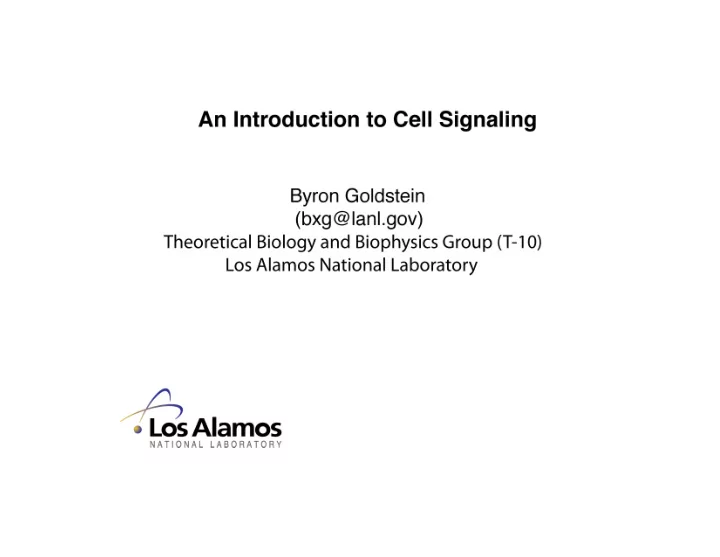

An Introduction to Cell Signaling: Outline 1. Question: How does the inside of a cell know something is happening on the outside of the cell? 1a. Receptors 1b. Plasma membrane 1c. Ligands 2. Answer: The inside of the cells knows when a chemical modification occurs inside the cell. 2a. Kinases (Src, Syk, Jaks) and phosphatases 2b. Protein domains (SH2, SH3, PH, kinase, etc.) 2c. EGFR and transphosphorylation 3. The players in a signaling cascade 3a. Receptors, non-membrane associated adaptors, scaffolding proteins, kinases, phosphatases, STATS, transcriptional factors
4. “General Principals” 4a. Combinatorial Complexity 4b. Serial engagement 4c. Kinetic proofreading 5. An Example of a signaling cascade - Fc ε RI and release of histamine.
Cells must constantly sense their environment and respond to it. How does the cell do this? How does the inside of the cell know that something has happened on the outside of the cell? It all starts with ligands binding to mobile receptors on the surface of cells.
For many receptor systems ligand induced receptor aggregation - bringing the cytoplasmic domains of receptors in proximity and holding them together for seconds to minutes – is required for signaling initiation.
Proteins can be phosphorylated on three classes of amino acids: 1. tyrosine 2. serine or threonine 3. histidine Only tyrosine and serine/threonine phosphorylation occurs in signaling in the immune system.
• Different ligands induce receptor aggregation in different ways.
• All the examples we have considered so far involve soluble ligands but often cell signaling is triggered by one cell binding to another cell. The “ligand” is now a surface with multiple binding sites.
• An example we study,the high affinity receptor for IgE, Fc ε RI, a key player in allergic reactions.
I've described the signaling events as if they were a linear chain (a path) but they aren't.
Recruitment of Syk to phosphorylated γ ITAM
Possible next steps after Lyn phosphorylates γ ITAM Recruitment of Syk to phosphorylated γ ITAM
Rates of protein dephosphorylation after addition of hapten
A Review Transmitting information across the cell membrane by juxtaposing the cytoplasmic tails of receptors is a ubiquitous signaling mechanism. By converting cytoplasmic domains of the receptor to phosphorylated forms, the cell “senses” the external ligand and initiates a signaling cascade. The phosphorylation of aggregated receptors reflects a dynamic balance between the action of kinase and phosphatases. If an aggregate breaks up, phosphatases rapildly dephosphorylate the receptor and the chemical modification is erased.
Kinetic Proofreading and Serial Engagement Kinetic proofreading - a series of events, e.g., building a scaffoldings about the receptor and additional transmembrane proteins, chemical modifications, is required for cell activation. Kinetic proofreading applies to a single receptor. It increases discrimination at the expense of sensitivity to a specific stimuli. It prevents false responses. Kinetic proofreading offers an explanation why basal phosphorylation of receptors does not lead to a cellular response. Serial engagement - a property of multivalent antigens (ligands or cells) - can dramatically increases the number of receptors that are activated. The combination of kinetic proofreading and serial engagement can result in a window of dissociation rate constants that can activate a cell.
Recommend
More recommend